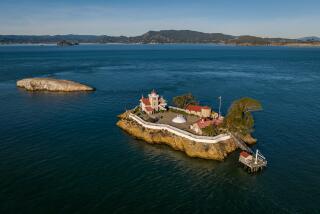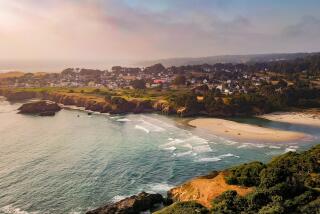Peggy’s Cove Is a Beacon Along Lighthouse Route
PEGGY'S COVE, Canada — “Many have trod the granite rocks and grassy plots, but few have watched the morning sun touch the steeple cross. . . .”
That is the first line from the ode to Peggy’s Cove by artist and sculptor William E. deGarthe, who lived and worked here on the Lighthouse Route along the Atlantic coast of Nova Scotia for 35 years until his death three years ago.
The poem is titled “Many Have Passed.” It goes on to add that “many have seen” Peggy’s Cove but have been “blind to the heartbeats inside the open doors.”
The words were written with a prayer they would be read by the many thousands of visitors who each year travel at least part of the 227-mile Lighthouse Route by car, RV, tour bus or bicycle.
We were fortunate to come upon the poem at the very beginning of the Lighthouse Route, scarcely an hour’s drive out of Halifax.
Historic Landmark
The doors of DeGarthe’s studio in Peggy’s Cove, a historic landmark along the trail, were open, and his widow Agnes told us about their lives. The moments with her gave a deeper meaning to his monumental sculpture on the wall of glacial granite outside their summer home.
The DeGarthes always shared the hope of his poem, that travelers could linger just a bit longer to listen, in the words of his ode, to more than “the sea gull’s cry.”
To see and experience Peggy’s Cove slowly, feeling “the breeze on sundrenched cheeks,” while listening to the “pounding surf on windswept shore,” opens the senses to all the other coves and storied villages along the Lighthouse Route.
The welcoming marker at the entrance to Peggy’s Cove states that the village was founded in 1811 and that its present population is 60. Even the drive into the village, and then the walk along the pathway between granite boulders to the dramatic lighthouse location, can be a memorable experience.
It’s easy to see why the cove has long been a fascination for artists and photographers from around the world. We stepped quietly around one boulder along the path so not to disturb a Japanese artist at work with his sketch pad.
The Story Unfolds
When we stopped at the Sou’Wester restaurant for a bowl of fish chowder, we picked up DeGarthe’s small booklet, “This Is Peggy’s Cove.” It was first published in 1956, is in its 21st printing and begins with his “Many Have Passed” ode. This led us to the meeting with Agnes deGarthe, and to other writings about the cove by friends and fellow villagers.
The story unfolded for us. The Micmac Indians were likely the first settlers. It was their base for summertime fishing and had been shaped for them by the Ice Age, which cleaned off much of the topsoil and sculptured the forms of 415 million-year-old Devonian granite that create the landscape.
After a land grant of 800 acres around the cove was given to six families in 1811, the fishing industry boomed and the lighthouse was built to help safeguard shipping along this wildly rugged Atlantic Maritime coast.
The cove is an oval about 300 yards deep and 150 yards wide, narrowing at the entrance for protection against the waves that can thunder in from the Atlantic.
In the glory days of the fishing industry, the population of the cove grew to 300 and there was a lobster factory to help furnish employment. When a great storm rolled over the protection of the cove and destroyed many of the fish industry installations, artists and travelers began to discover this picturesque outpost community so close to Halifax.
‘Pearl of the Atlantic’
To protect the heritage of this “Pearl of the Atlantic” the lands around the village were taken over by the Crown and closed to future development. In 1962 Peggy’s Cove Commission was formed to regulate any building or building changes within the village.
The famous lighthouse has been preserved on its rocky cliff at the edge of the sea, and is best known as the only lighthouse post office in Canada. Collectors of postal memorabilia make a point to have their cards and letters stamped there. The Crooks family has run the post office for nearly a century. When Wesley Crooks retired at age 99 in 1934, he had been the oldest postmaster in Canada.
How did Peggy’s Cove get its name? The most romantic story, and the one most generally accepted, is that in the early days of the village a schooner was wrecked on Halibut Rock off Lighthouse Point. Everyone on board was lost except a woman named Margaret who was washed ashore to become the bride of a handsome fisherman. She became legendary as Peggy of the Cove.
This was a story made to order for the imagination of William deGarthe. He used her charming figure and profile as a centerpiece of his monumental sculpture. Full-breasted, she has an animated swing to her hips even in stone as she looks back at the sea from which her life was spared.
The figures of 30 fishermen at work are incorporated into this monument dedicated to Nova Scotia fishermen. They handle an anchor and large fish, carry a lobster trap, haul nets--all reminders that fishing is still the villagers’ basic year-round occupation.
Religious Feelings
“The Guardian Angel” sheltering the people of the village with her outstretched hands reflects DeGarthe’s deeply religious feelings. He started work on this stone sculpture in 1977 and continued it for the next six summers, sometimes with the help of two talented friends.
In the chapel of the Church of St. John’s, built around the year 1850, are two murals by DeGarthe. One reflects storm and turbulence endangering a fishing boat at sea. The other shows the calmness and serenity of the figure of Christ above the waters and against the outline of Lighthouse Point.
Agnes deGarthe told us it was about 40 years ago that she and her husband first visited Peggy’s Cove. It didn’t take them long to decide that this was the place for their summer home. DeGarthe was already a noted artist. He had studied and painted in Montreal, New York and Italy. Many of his award-winning paintings are in private collections, and he has exhibited with the Royal Society of Marine Paintings in London.
During summer and autumn, Agnes deGarthe welcomes visitors into the Marine Studio where his paintings are displayed. The studio was a general store when it was almost swept over the cliff by a storm in the winter of 1898.
DeGarthe has written about working in this studio for many summers, always happy to be interrupted to exchange tales with visitors. The DeGarthes enjoyed the church lobster suppers, minstrel shows and other events still held in the nearby Community Hall, built in 1900.
Agnes deGarthe winters in Florida now, but looks forward to returning to the cove and village friends of many years. She has given the monumental stone sculpture of the fishermen to the people of Canada, and it is a national memorial site. Two years before his death, DeGarthe cut a crypt into the rock face where the mortal remains of he and his wife could be together.
Pedaling From Halifax
Before leaving Peggy’s Cove we met an Open Road tour group of 16 U.S. cyclists, just reaching here after the first day of pedaling from Halifax. They had assembled in Halifax by air from as far away as Arizona, and were off for 11 leisurely days of exploring the Lighthouse Route as far as Lunenberg, then circling back to their starting point.
We drove on with the dream of returning to the Lighthouse Route with our own tandem bicycle. But for now we continued driving a small part of the route at the pace to which we had been conditioned by William and Agnes deGarthe. There was no way we would ever try to drive the entire 227 miles to Yarmouth during any one visit.
How could you possible hurry by Oak Island where some of Capt. Kidd’s booty is still supposed to be buried? Or not linger in Lunenberg, one of the most unusual architectural towns in North America? The original Bluenose racing schooner, and the Bluenose II replica now sailing out of Halifax, were built at this peninsula fishing center that has a Craft Festival staged by artists and craftsmen every mid-July.
The heritage of the Acadians and even the early Norse seafarers is preserved in village life and museums all along the Lighthouse Route, cutting through the tapestry of blue sea, cliffs and green forests. At Bridgewater the LaHavre River, known as the Rhine of Nova Scotia, flows into the Atlantic.
About 10 minutes from Peggy’s Cove we met some of the Open Road bicycle group again as they were checking into Seabright Bed & Breakfast with its private beach overlooking St. Margaret’s Bay. The rates for a twosome in the six cozy guest rooms and two cottages is $35.
At the tourist office in downtown Halifax we picked up a copy of the “South Shore Guide to Nova Scotia,” which details the entire Lighthouse Route. For information about the Open Road bicycle tour in Nova Scotia and many other parts of the world, contact Open Road Bicycle Tours Ltd., 1601 Summit Drive, Haymarket, Va. 22069, phone (703) 754-4152.
More to Read
Sign up for The Wild
We’ll help you find the best places to hike, bike and run, as well as the perfect silent spots for meditation and yoga.
You may occasionally receive promotional content from the Los Angeles Times.






